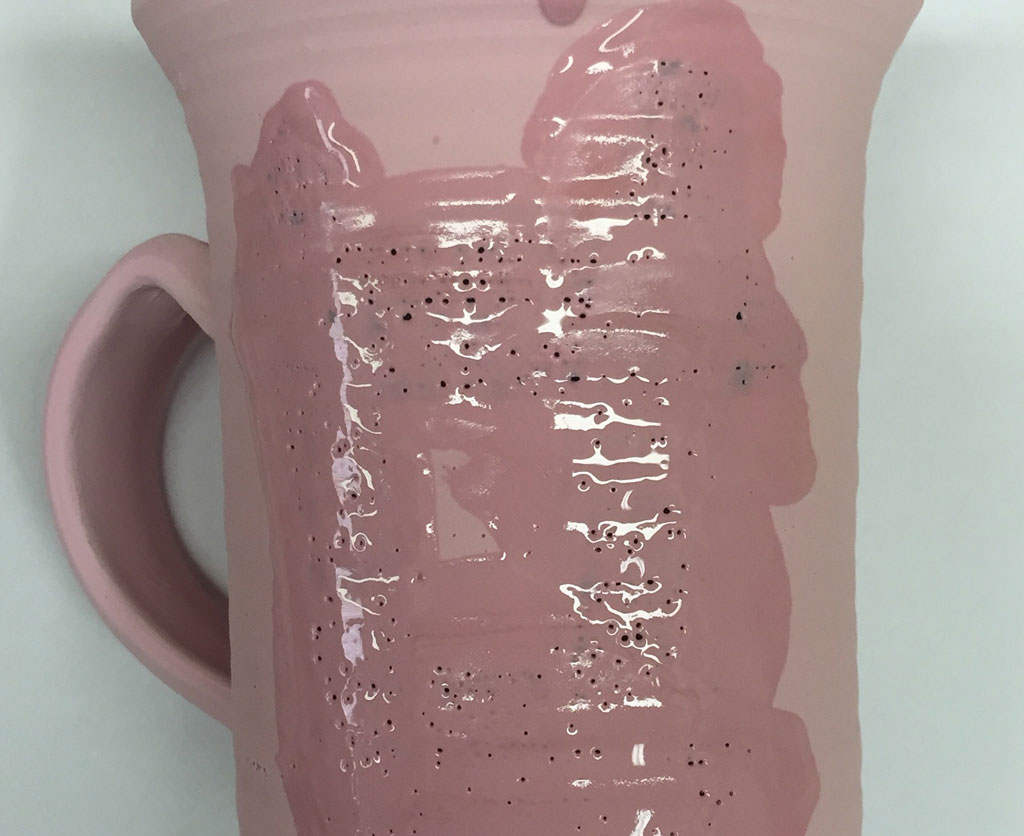| Monthly Tech-Tip | No tracking! No ads! |
Our own black underglaze better accepts the clear overglaze
The commercial product has two serious issues. First, it is just not covering well enough, to get jet black requires three or four coats. Second, it is intended for transparent brushing glazes over top - dipping glazes do not cover well over it, even when the underglaze is bisque fired (upper left). By contrast, our own black (90% MNP, 10% Nepheline Syenite, 10% black stain, 1.5% CMC gum, 5% bentonite) overglazes perfectly (upper right). And one brush stroke almost covers enough (we later settled on 15% stain).
Related Pictures
When a DIY black underglaze makes sense

This picture has its own page with more detail, click here to see it.
Black brushwork needs to go on thick enough in one brushstroke. Commercial products we have don't do that - thus my motivation to work on this. Another issue is that they try to cover too wide a firing range (thus they melt too much at the high end and not enough at the low end). I am experimenting on cone 6 Polar Ice porcelain jiggered bowls using G2926B dipping glaze. The base underglaze recipe here is a 90:10 MNP:nepheline syenite mix (you could use your own porcelain instead of MNP and feldspar instead of nepheline). To that, I add 15% black stain, 1.5% CMC gum and 5% bentonite. With the CMC gum and bentonite, and blender mixing, a brushable consistency that stays put can be achieved at a fairly low water content compared to commercial products (enabling it to go on thicker in a single brush stroke). Assuming application at leather hard state, the drying and firing shrinkage can be matched to the body by varying the plasticity of the porcelain used (e.g. the percentage of bentonite it contains). And the percentage of stain can be tuned for enough color but no bleeding, bubble clouding or crystallization. And we can adjust the degree of maturity by varying the proportions of MNP and Nepheline (commercial underglazes often melt too much by cone 6 and fade and diffuse as a result), this one stays opaque black.
Underglazes suitable for making silk screen transfers are another special case. The ideal one needs to cover well like this one. But it also needs to gel and harden enough to hang onto the paper but not so hard that it does not separate and transfer to the ware. Commercial products for brushing are unlikely to be optimal so it makes sense to mix your own and experiment with different amounts of gum.
Underglaze decoration difficult to cover with clear overglaze

This picture has its own page with more detail, click here to see it.
The underglaze was painted on to bisque ware (has not be fired on). This is a problem. It has a high gum content and has sealed the surface so the porous body underneath is unable to pull water out to dry it quickly. During the slow dry the little absorption that is taking place is generating air bubbles from below and these are producing bare spots. The solution is to either make your own underglaze having a lower gum content or decorate ware in the dry or leather hard stage so the bisque fire will neutralize the gum.
Why dipping transparent glazes may not cover underglazes well

This picture has its own page with more detail, click here to see it.
Underglaze brushstrokes were applied to this test cup at the leather hard stage (lower left) and then bisque fired on. On the lower right a ball of the pure underglaze emerged from the same bisque firing, notice that it is certainly fusing enough to seal the surface of the bisque. Notice what happened on the upper left: Although the bisque piece was immersed in a dipping glaze the underglaze is not covered. Yet on the upper right a just-applied transparent brushing glaze has covered well (although three coats were needed with plenty of drying time between). Why is this? Brushing underglazes contain a lot of CMC gum, it makes them spread well like paint - and dry hard (but also denser and less absorbent). Manufacturers of brushing underglazes assume that gummed brushing glazes will also be used over their products. How can coverage be achieved using a DIY transparent? Mixing your glaze as a thixotropic slurry, a first coat dipping glaze or even as a brushing glaze.
Underglaze color mayhem at cone 5!

This picture has its own page with more detail, click here to see it.
These are commercial underglaze colors fired in a flow tester. Underglazes are not pure stains, they are a blend of stain powders with a host recipe (a porcelain-like mix of clay, frit, silica) that matures enough to fuse to the body but not so much that it melts. The blue, green and red are from one manufacturer. Stain powders have different melting temperatures and require differing percentages to get color intensity, the base recipe of the medium should compensate for that. That is not being done here, the pink one needs less flux and the green needs more. The black underglaze (D) (from a second manufacturer) has liquefied, gassed out and is about to head down the runway! The E black (a third manufacturer) has not even started to melt or even sinter. The black engobes were plastic, the colored ones were not, likely an indication that black requires a much lower stain percentage in the engobe recipe.
Got a Question?
Buy me a coffee and we can talk

https://digitalfire.com, All Rights Reserved
Privacy Policy

